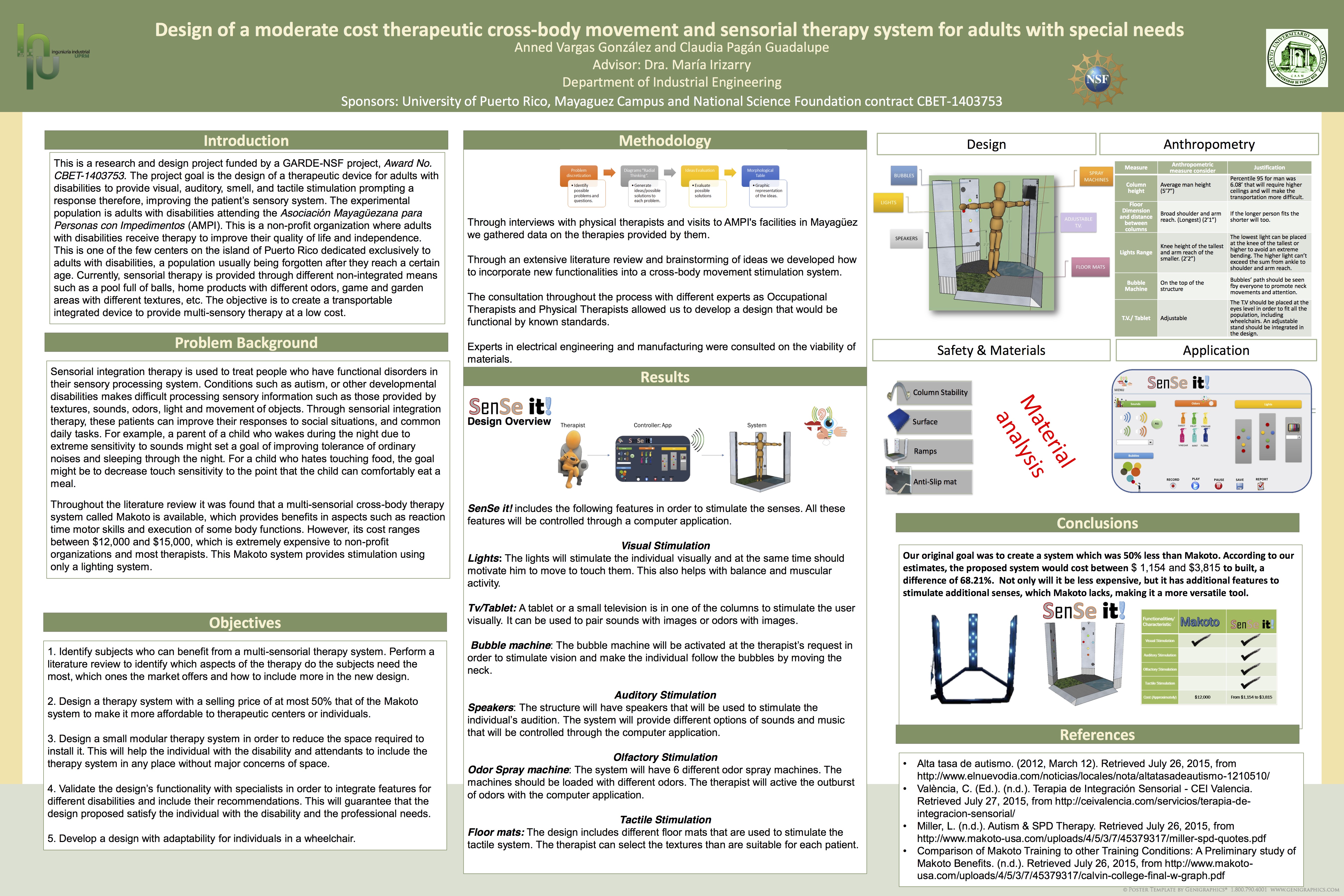Making the Difference: Design of a cost-effective therapeutic cross-body movement and sensorial therapy system for adults with special needs
Student Team:
Claudia Pagán, Industrial Engineering Senior Student
Anned Vargas, Industrial Engineering Senior Student
Beliertano Carambot Flores, Electrical Engineering Senior Student
José F. Martinez Cruz, Electrical Engineering Senior Student
Miguel Além Arias, Electrical Engineering Senior Student
Sarah Couto Sáncez, Electrical Engineering Senior Student
Faculty Mentors:
María Irizarry, PhD
Cristina Pomales, PhD
Mayra Méndez, PhD
Raul Torres, PhD
Project Synopsis:
Making the Difference: Design of a therapeutic device for adults with disabilities to provide visual, auditory, smell, and tactile stimulation is part of a project sponsored by the National Science Foundation (NSF) that seeks to benefit adults with disabilities. The objective of the project was to design an integrated and cost-effective therapeutic device to provide visual, auditory, and tactile stimulation for adults with multiple disabilities. The project’s goal was the design of a therapeutic device to improve a patient’s sensory system. The experimental population is adults with disabilities attending the Mayaguez Association for People with Disabilities (AMPI). AMPI is a non-profit organization where adults with disabilities receive therapy to improve their quality of life and independence. Currently, sensorial therapy is provided through different non-integrated means. Sensorial integration therapy is used to treat people who have functional disorders in their sensory processing system. Conditions such as autism, or other developmental disabilities makes difficult processing sensory information such as those provided by textures, sounds, odors, light and movement of objects. Through sensorial integration therapy, these patients can improve their responses to social situations, and common daily tasks. A commercial multi-sensorial cross-body therapy system is available in the market which provides benefits in aspects such as reaction time and the execution of some body functions. However, its cost ranges between $12,000 and $15,000, which is extremely expensive to non-profit organizations and most therapists. The methodology used in this project included: (1) problem discretization, (2) generation of designs through radial thinking, (3) evaluation of design’s viability and, (4) morphological analysis including images and sketches of the design alternatives. It also included interviews with physical therapists, visits to AMPI’s facilities and, interviews with experts in electrical engineering on the viability of materials. In 2015 the project design phase was completed. The project’s goal was to design a system with an estimated cost 50% less than Makoto. Based on the proponents’ estimates the system can be built at a cost between $ 1,154 and $3,815 which represents a minimum reduction of 68.21% compared to Makoto. Not only will it be less expensive, but it has additional features to stimulate senses, making it a more versatile tool.
During the fall of 2016 a new capstone team of Electrical Engineering Students built the system to provide multisensory therapy to people with intellectual and motor disabilities. It integrates different therapy modules that stimulate visual, auditory, and olfactory senses in the same machine. Each therapy module complement each other to give a multisensory treatment. Also, the system can also be used to complement the therapies that it offers with other therapies that the patient receives. The system is not intended to diagnose a condition nor to cure it, but it serves as a tool for therapists to measure patient progress through clinical observations. The therapist who manages the system have complete control of the pre-programmed therapies sequence through a tablet which allows the interaction and communication with the system. System requirements and specifications were established considering the objectives set by the client. The structure of the system has been redesigned considering the ergonomic analysis previously performed by the Industrial Engineering team. This project phase focused on hardware and software design and implementation which is documented on this final report.
This project was supported by the National Science Foundation contract CBET-1403753, “Making the Difference: An Industrial Engineering Capstone Design Experience to Benefit Adults with Disabilities.”

